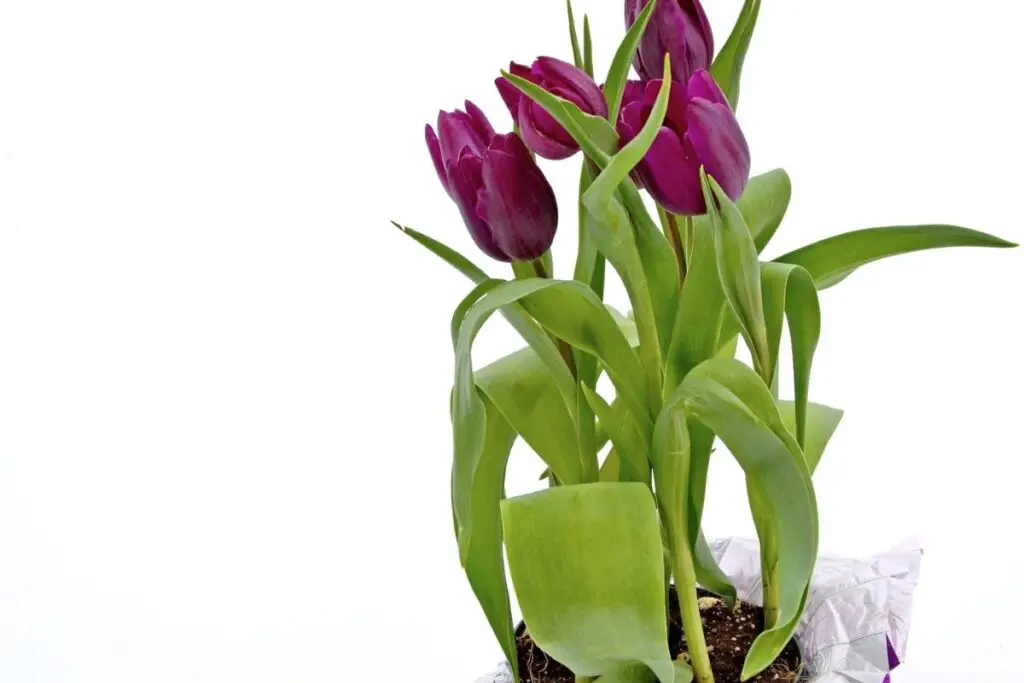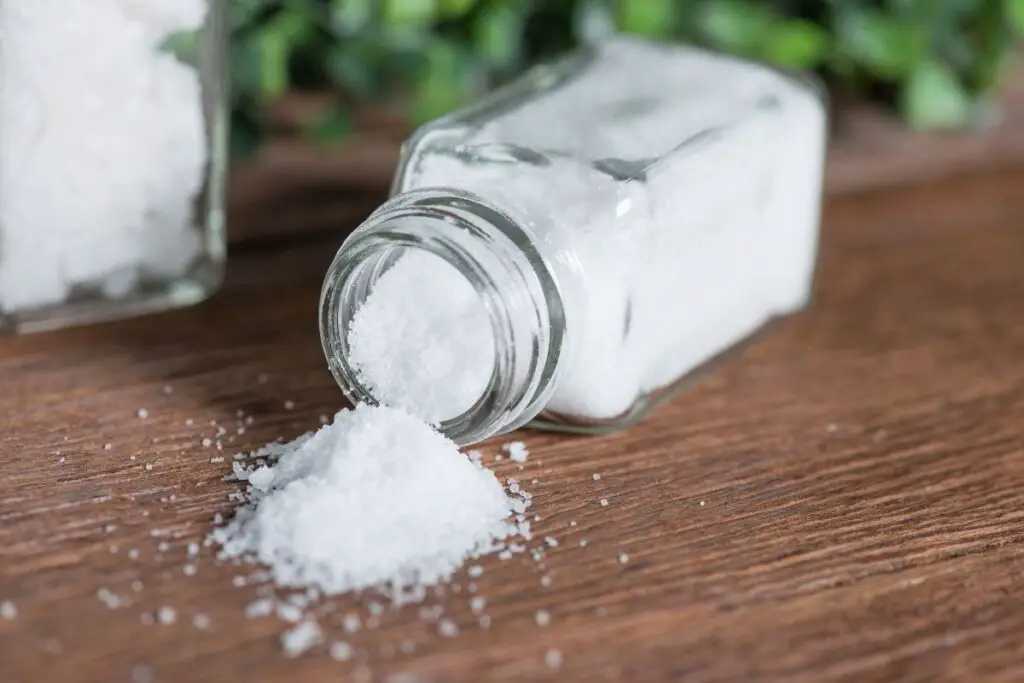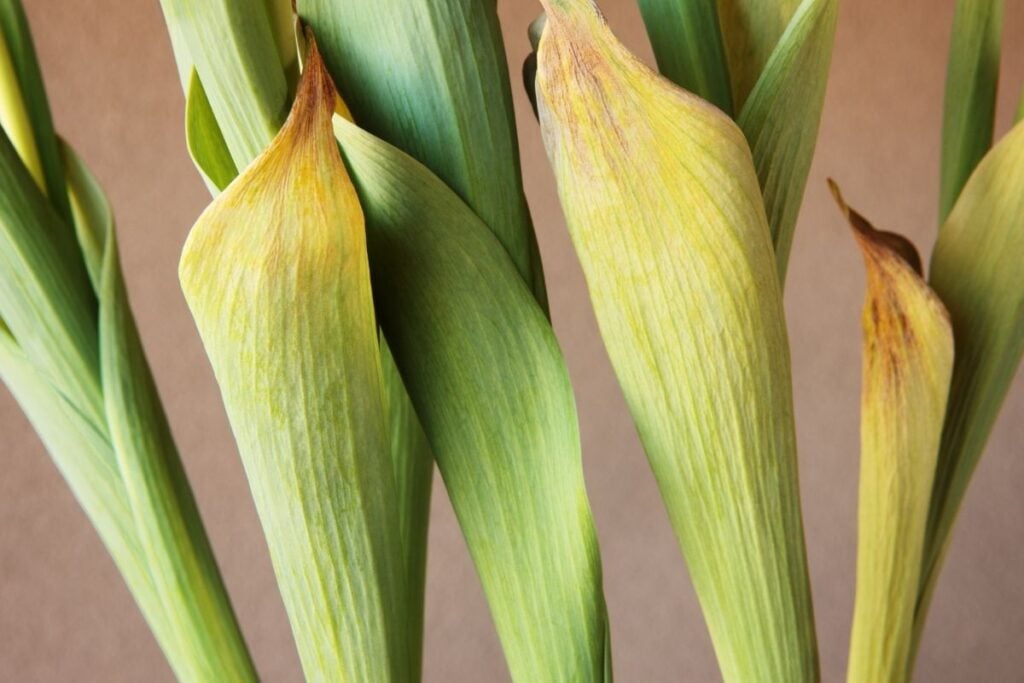Using Epsom salt on houseplants has recently become a popular gardening hack due to its inexpensive and low-maintenance application. But, in reality, this is no new trend, and these white crystals have been around in the gardening supply shed for many generations now.
But is Epsom salt good for tulips? Let’s find out.
As a general rule, Epsom salt is an excellent supplement for magnesium deficiency which can inhibit the bloom in tulips. However, it would be best to use it in conjunction with traditional fertilizer as it doesn’t contain all the nutrients needed by the plants. Also, be cautious of overdose.
Let’s find out if Epsom salt is suitable for tulips and how you can use it to benefit these plants.

What are Epsom Salts?
Epsom Salts refer to a chemical compound made from hydrated magnesium sulfate. They consist of 10% magnesium and 13% sulfur.
The discovery of Epsom Salt dates back to the early 1600s, in an underground mine in Epsom, England.
Epsom salts have been used throughout history to treat various conditions in plants, animals, and humans to boost their health.
It is believed that Epsom salts can heal wounds, make your skin softer, soothe sore muscles and help you sleep better.
In addition to banana peels, coffee grounds, and eggshells, Epsom Salts have also been one of the best organic fertilizers.
Why is Epsom salt good in the garden?
Let’s look at the benefits of using Epsom salt.
As soil amendment: Epsom Salts can significantly improve the fertility and productivity of the soil. The sulfur present in Epsom salts actively works to dissolve the calcium present in the soil. This will ensure that the rate of plant growth increases.
Certain types of soil, like acidic soil, benefit more from Epsom salt, as they can quickly neutralize the ground’s high pH levels. Thus, it is crucial to conduct a soil test on your soil to determine the quantity of Epsom salt that the soil needs.
As a seed starter: A diluted mixture of Epsom Salts can work to help the plant seeds germinate at a faster rate. This will ensure that the seeds have strong cell walls and do not fall prey to magnesium deficiency early in their growth cycle.
Remedies of magnesium deficiency: Epsom Salt is primarily known for getting rid of magnesium deficiency. When the leaf foliage turns yellow, brown, and red around the edges, it signals a deficit.
Epsom Salt cannot reverse the discoloration of a plant back to its original state, but it’s an excellent way to make sure that no more color is lost.
Also read: What Kind Of Soil Is Good For Tulips? (Best Soil Mix)
Looking for gardening supplies? We have tested 100's of products before recommending them to you guys. Check out our best pick below:
| Image | Gardening Supplies | Best Price? |
|---|---|---|
 Top
Top Top
Top | Raised Garden Bed Kit | Check On Amazon |
 | XLUX Soil Moisture Meter, Plant Water Monitor, Soil Hygrometer Sensor for Gardening, Farming, Indoor and Outdoor Plants, No Batteries Required | No Results |
 Top
Top Top
Top | 82 Pcs Garden Tools Set and Extra Succulent Tools Set | Check On Amazon |
 | Joeys Garden Expandable Garden Hose with 8 Function Hose Nozzle, Lightweight Anti-Kink Flexible Garden Hoses, Extra Strength Fabric with Double Latex Core, (50 FT, Black) | No Results |
 Top
Top Top
Top | Dual Chamber Compost Tumbler | Check On Amazon |
 Top
Top Top
Top | Sunnyglade Plant Stakes | Check On Amazon |
 Top
Top Top
Top | Organic Cold Pressed Neem Seed Oil | Check On Amazon |
 Top
Top Top
Top | Mighty Mint Gallon :-Insect and Pest Control Peppermint Oil | Check On Amazon |
 Top
Top Top
Top | Scotts DiseaseEx Lawn Fungicide | Check On Amazon |
 Top
Top Top
Top | Jacks Classic 20-20-20 All Purpose Fertilizer | Check On Amazon |
 Top
Top Top
Top | 30,000 Seeds Pollinator Attracting Wildflower Mixture | Check On Amazon |
 Top
Top Top
Top | Survival Vegetable Seeds Garden Kit-Over 16,000 Seeds | Check On Amazon |
Is Epsom salt good for tulips?

Yes, Tulip plants respond exceptionally well to Epsom Salts under most circumstances. The main mineral components of Epsom salt, Magnesium, and Sulfur are essential for plants, including tulips.
The survival and reblooming chances of tulips after the harsh winter can be enhanced by proper fertilization. Using Epsom Salt as an organic fertilizer can invigorate the blooming of flowers and leaves.
It can help instill a suitable self-defense mechanism within the tulips and contribute to the overall aesthetic of the garden.
Epsom salt is recommended to be safe for all species and varieties of tulips. In comparison to commercial fertilizers, they pose an almost negligible danger of overuse.
Epsom Salt cannot magically solve every gardening problem, but it will simplify and better the entire planting and growth experience of tulips to a great extent.
The benefits of using Epsom salt as a fertilizer
You can even use Epsom salt as fertilizer or add it to the fertilizer you use for your plants.
Increases nutrient uptake: Epsom salt is proficient at giving Magnesium to the tulip plant and allows the plant to perform its other essential functions better. One of the functions includes strengthening the plant’s ability to absorb the vital nutrients; nitrogen and phosphorus.
Enhances the greenery: As we all know, the phenomena of photosynthesis aids the plant in producing food and energy for itself. The Magnesium in the Epsom salts can stimulate the creation of chlorophyll in the tulip plant.
This chlorophyll is responsible for the intensity of the plant’s leaf color and the lushness of the foliage.
Acts as a pesticide: Applying Epsom Salt on the base of your tulips and other indoor plants will help curb the spread of harmful garden pests, including slug, voles, and snails.
Balances nutrients: If you notice the underperformance of your plants, Epsom Salt can help balance the nutrient levels in no time by supplementing the plant with deficient minerals.
Also read: What Is The Best Fertilizer For Tulips? (Organic+Inorganic)
How much should Epsom salt be used on tulips?
You should decide the ratio of Epsom Salt based on the plants you are treating, the soil type, and the application method.
Applying the Epsom salt twice a month will suffice to meet the Tulips’ needs.
If you are a beginner in applying Epsom salt, one to two tablespoons (30 ml) per gallon of water will be the ideal measurement to treat tulips. After that, you can up your dose to ¼ cup per gallon if the tulip plants show no damage after the first use.
To maintain a more regular watering routine, cut the supply of Epsom salt back to only one tablespoon. The recommended dose is 1-3 cups of Epsom salt per gallon of water for soil drenching.
How to apply Epsom salt to tulips?
The best way to apply Epsom salt on tulips is to spray it on the foliage. You can add the Epsom Salt to water, mix them and spray on the tulip plants. This can work wonders for its development.
Adding Epsom salts to the water and watering the soil with it is another viable method of making the salts reach the tulips.
Finally, when planting the tulip bulbs, opt for applying Epsom salt directly to the soil. This will allow the Epsom salt to travel upwards into the roots of the tulip plant.
The best time to apply Epsom salt
The most suitable time to apply Epsom salt is overcast, cloudy, and pleasant weather day.
Avoid using your salts when there’s a bright sun shining with all its power outside. This is because the intense sunlight can burn the foliage of your tulip.
There isn’t a specific season suited for Epsom salt application, but they are usually used when sprouting the tulip buds. This would make the end of winter and the advent of Spring good months to apply Epsom salt on your tulips for fast action.
The adverse effects of using Epsom salt

Using an excess of Magnesium sulfate in the form of Epsom salts can cause salt injury to your plants.
In this process, the bud scales suffer desiccation and ultimately expose tender tissues of the developing flowers in the tulip.
As a result, the unprotected plant parts become more susceptible to soil-borne diseases. Often, you cannot save the plants since their damage is detected when it’s too late.
The common signs of salt injury/damage include:
- Death of buds and stems
- Browning and discoloration of the flowers and leaves
- Wilting
- Delayed sprouting and flower blooming
A significant reduction in the root colonization of beneficial nitrogen-fixing bacteria is also connected to an overuse of Epsom salts.
Adding high amounts of Magnesium can lead to the release of aluminum from the soil. This toxic metal can potentially harm plant and aquatic systems.
It is critical to note that Magnesium and sulfur are labeled as minor nutrients. This means that they are only required in small quantities.
Nitrogen, Phosphorus, and Potassium (NPK) are the primary nutrients required by the plant.
In that sense, Epsom salts have a nutrient value of 0:0:0 due to no trace of N:P:K. Naturally, using it as a primary fertilizer will eradicate the plant.
The only way to prevent Magnesium toxicity is to ensure that the calcium content in the soil stays a minimum of 10 times higher than Magnesium.
Most soils available in the western and mid-west states already have an abundance of magnesium present. Most composts and common fertilizers also contain more than enough Magnesium to supplement the lack.
Thus, the application of Epsom salts can instead cause an imbalance of nutrients and create a destructive environment for plant growth.
A magnesium deficiency is not always as simple as it appears. Plants can suffer from magnesium deficiency when the phosphorous content of the soil gets too high.
Too much phosphorus can hinder the absorption of Magnesium by the soil. In such a case, using Epsom salts will only delay finding the real reason behind the magnesium deficiency.
Also, you should refrain from using Epsom salts if your soil is acidic, as that can worsen the problems your plants face.
Final words
Now that you have enough information both for and against Epsom salts, you can use them most beneficially for your tulips. There is no doubt that Epsom salts can tangibly rejuvenate the tired tulip plants and reduce their stress.
But in expert opinion, Epsom salts should be used to provide a kick to your plants that have gotten too comfortable. But it is best not to depend on them as the sole fertilizer that would give your tulips wholesome nourishment.
Now that you have enough information both for and against Epsom salts, you can use them in the most beneficial way possible.
Source: Wikipedia, North Dakota Stae University, The Royal Horticultural Society.
